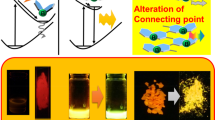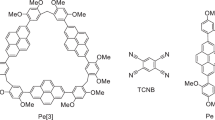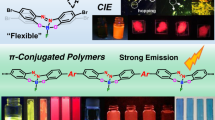Abstract
Element-blocks, the minimum heteroatom-containing functional units, are versatile building blocks for constructing functional polymers. In this focus review, we explain the new concept of developing stimuli-responsive luminochromic materials based on frustrated element-blocks. Herein, we termed “frustrated” element-blocks as those that show a relatively larger degree of structural relaxation in the excited state but are structurally restricted. As a result, frustrated element-blocks can have unique stimuli-responsive luminochromic behaviors. As a representative example, the stimuli-responsive properties of frustrated boron clusters are initially illustrated, and a series of their luminochromic properties, such as mechano- and thermochromism, are described. Next, we designed fused complexes for suppressing intramolecular motion to obtain frustrated boron complexes that display constant emission in both the solution phase and solid-state to produce mechanochromic luminescent materials. Finally, generating the frustrated state by polymerization is explained. These polymers display unique luminochromic behaviors, such as thermochromism in solution, mechanochromism in the solid-state and vapochromism. Finally, the stimuli-responsive luminochromic behaviors of frustrated element-block-containing polymers and their mechanisms are illustrated, mainly by examples from our recent works.
This is a preview of subscription content, access via your institution
Access options
Subscribe to this journal
Receive 12 print issues and online access
$259.00 per year
only $21.58 per issue
Buy this article
- Purchase on Springer Link
- Instant access to full article PDF
Prices may be subject to local taxes which are calculated during checkout














Similar content being viewed by others
References
Ito S, Gon M, Tanaka K, Chujo Y. Recent developments in stimuli-responsive luminescent polymers composed of boron compounds. Polym Chem. 2021;12:6372–80.
Kawano Y, Ito Y, Ito S, Tanaka K, Chujo Y. π-conjugated copolymers composed of boron formazanate and their application for a wavelength converter to near-infrared light. Macromolecules. 2021;54:1934–42.
Ito S, Ito Y, Tanaka K, Chujo Y. Near-infrared-emissive π-conjugated polymers based on five-coordinated silicon formazanate complexes. Polymer. 2022;239:124463.
Chujo Y, Tanaka K. New polymeric materials based on element-blocks. Bull Chem Soc Jpn 2015;88:633–43.
Gon M, Tanaka K, Chujo Y. Recent progress in the development of advanced element-block materials. Polym J. 2018;50:109–26.
Tanaka K, Chujo Y. Modulation of the solid-state luminescent properties of conjugated polymers by changing the connecting points of flexible boron element-blocks. Polym J. 2020;52:555–66.
Yamaguchi M, Ito S, Hirose A, Tanaka K, Chujo Y. Luminescent color tuning with polymer films composed of boron diiminate conjugated copolymers by changing connection points to comonomers. Polym Chem. 2018;9:1942–6.
Himeno R, Ito S, Tanaka K, Chujo Y. Synthesis, crystal structure, solid-state optical property and C‒H activation of sp3 carbon of highly-stable 1-(2′,6′-Dimesitylphenyl)-2,3,4,5-tetraphenylborole. N J Chem. 2021;45:22569–73.
Gon M, Tanaka K, Chujo Y. Concept of excitation-driven boron complexes and their applications for functional luminescent materials. Bull Chem Soc Jpn 2019;92:7–18.
Balents L. Spin liquids in frustrated magnets. Nature. 2010;464:199–208.
Stephan DW. The broadening reach of frustrated Lewis pair chemistry. Science. 2016;354:aaf7229.
Ochi J, Tanaka K, Chujo Y. Experimental proofs for emission annihilation through bond elongation at the carbon‒carbon bond in o-carborane with fused biphenyl-substituted compounds. Dalton Trans. 2021;50:1025–33.
Naito H, Nishino K, Morisaki Y, Tanaka K, Chujo Y. Solid-state emission of the Anthracene−o-Carborane dyad via twisted-intramolecular charge transfer in the crystalline state. Angew Chem Int Ed. 2017;56:254–9.
Ochi J, Tanaka K, Chujo Y. Recent progresses in the development of solid-state luminescent o-Carboranes with stimuli responsivity. Angew Chem Int Ed. 2020;132:9841–55.
Nishino K, Tanaka K, Chujo Y. Tuning of sensitivity in thermochromic luminescence by regulating molecular rotation based on triphenylamine-substituted o-Carboranes. Asian J Org Chem. 2019;8:2228–32.
Ochi J, Yuhara K, Tanaka K, Chujo Y. Controlling the dual-emission character of aryl-modified o-carboranes by intramolecular CH···O interaction sites. Chem Eur J. 2022;28:e202200155.
Suenaga K, Tanaka K, Chujo Y. Modulation of properties by ion changing based on luminescent ionic salts consisting of Spirobi(boron ketoiminate). Molecules. 2022;27:3438.
Nishino K, Hashimoto K, Tanaka K, Morisaki Y, Chujo Y. Comparison of luminescent properties of helicene-like bibenzothiophenes with o-Carborane and 5,6-Dicarba-nido-decaborane. Sci China Chem. 2018;61:940–6.
Wada K, Hashimoto K, Ochi J, Tanaka K, Chujo Y. Rational design for thermochromic luminescence in amorphous polystyrene films with the Bis-o-carborane-substituted enhanced-conjugated molecule having aggregation-induced luminochromism. Aggregate. 2021;2:e93.
Yamamoto H, Ochi J, Yuhara K, Tanaka K, Chujo Y. Switching between intramolecular charge transfer and excimer emissions in solids based on Aryl-modified Ethynyl‒o-Carboranes. Cell Rep. Phys Sci. 2022;3:100758.
Yuhara K, Tanaka K, Chujo Y. Regulation of solid-state dual-emission properties by switching luminescence processes based on a Bis-o-carborane-modified anthracene triad. Mater Chem Front. 2022;6:1414–20.
Ochi J, Tanaka K, Chujo Y. Dimerization-induced solid-state excimer emission showing consecutive thermochromic luminescence based on Acridine-Modified o-Carboranes. Inorg Chem. 2021;60:8990–7.
Nishino K, Yamamoto H, Tanaka K, Chujo Y. Time-dependent emission enhancement of the Etynylpyrene-o-Carborane dyad and its application as a luminescent color sensor for evaluating water contents in organic solvents. Chem Asian J. 2019;14:1577–81.
Ochi J, Tanaka K, Chujo Y. Improvement of solid-state excimer emission of the Aryl−Ethynyl−o-Carborane skeleton by acridine introduction. Eur J Org Chem. 2019;2019:2984–8.
Nishino K, Yamamoto H, Tanaka K, Chujo Y. Solid-state themochromic luminescence via twisted intramolecular charge transfer and excimer formation of the carborane-pyrene dyad with an ethynyl spacer. Asian J Org Chem. 2017;6:1818–22.
Tanaka K, Chujo Y. Recent progress of optical functional nanomaterials based on organoboron complexes with β-Diketonate, Ketoiminate and Diiminate. NPG Asia Mater. 2015;7:e223.
Ito S, Gon M, Tanaka K, Chujo Y. Molecular design and applications of luminescent materials composed of group 13 elements with an aggregation-induced emission property. Natl Sci Rev. 2021;8:nwab049.
Suenaga K, Tanaka K, Chujo Y. The positive luminescent sensor for aerobic conditions based on polyhedral oligomeric silsesquioxane networks. Chem Res Chin Univ. 2021;37:162–5.
Suenaga K, Yoshii R, Tanaka K, Chujo Y. Sponge-type emissive chemosensors for the protein detection based on boron ketoiminate-modifying hydrogels with aggregation-induced blueshift emission property. Macromol Chem Phys. 2016;217:414–7.
Suenaga K, Tanaka K, Chujo Y. Design and luminescent chromism of fused boron complexes having constant emission efficiencies in solution and in the amorphous and crystalline states. Eur J Org Chem. 2017;2017:5191–6.
Saotome S, Suenaga K, Tanaka K, Chujo Y. Design for multi-step mechanochromic luminescence property by enhancement of environmental sensitivity in a solid-state emissive boron complex. Mater Chem Front. 2020;4:1781–8.
Suenaga K, Uemura K, Tanaka K, Chujo Y. Stimuli-responsive luminochromic polymers consisting of multi-states emissive fused boron ketoiminate. Polym Chem. 2020;11:1127–33.
Ito S, Yaegashi M, Tanaka K, Chujo Y. Reversible vapochromic luminescence accompanied by planar half-chair conformational change of a propeller-shaped boron β-Diketiminate complex. Chem Eur J. 2021;27:9302–12.
Ito S, Tanaka K, Chujo Y. Characterization and photophysical properties of a luminescent aluminum hydride complex supported by a β-Diketiminate ligand. Inorganics. 2019;7:100.
Yamaguchi M, Ito S, Hirose A, Tanaka K, Chujo Y. Modulation of sensitivity to mechanical stimulus in mechanofluorochromic properties by altering substituent positions in solid-state emissive diiodo boron diiminates. J Mater Chem C. 2016;3:5314–9.
Ito S, Fukuyama M, Tanaka K, Chujo Y. Effects of regioregularity of π-Conjugated polymers composed of boron β-Diketiminate on their stimuli-responsive luminescence. Macromol Chem Phys. 2022;223:2100504.
Gon M, Ito S, Tanaka K, Chujo Y. Design strategies and recent results for near-infrared- emissive materials based on element-block π-Conjugated polymers. Bull Chem Soc Jpn. 2021;94:2290–302.
Gon M, Tanaka K, Chujo Y. Discovery of functional luminescence properties based on flexible and bendable boron-fused Azomethine/Azobenzene Complexes with O,N,O-Type Tridentate Ligands. Chem Rec. 2021;21:1358–73.
Gon M, Wakabayashi J, Tanaka K, Chujo Y. Unique substitution effect at 5,5’-Positions of fused Azobenzene–Boron complexes with a N = N π-Conjugated system. Chem Asian J. 2019;14:1837–43.
Nakamura M, Gon M, Natsuda S, Tamai Y, Ohkita H, Tanaka K, et al. Development of NIR emissive fully-fused bisboron complexes with π-Conjugated Systems including multiple Azo groups. Dalton Trans. 2022;51:74–84.
Gon M, Tanimura K, Yaegashi M, Tanaka K, Chujo Y. PPV-Type π-Conjugated polymers based on hypervalent Tin(IV)-fused Azobenzene complexes showing near-infrared absorption and emission. Polym J. 2021;53:1241–9.
Gon M, Tanaka K, Chujo Y. Vapochromic luminescent π-Conjugated systems with reversible coordination-number control of hypervalent Tin(IV)-Fused Azobenzene complexes. Chem Eur J. 2021;27:7561–71.
Gon M, Wakabayashi J, Nakamura M, Tanaka K, Chujo Y. Preparation of near-infrared emissive π-Conjugated polymer films based on boron-fused azobenzene complexes with perpendicularly protruded Aryl substituents. Macromol Rapid Commun. 2021;42:2000566.
Wakabayashi J, Gon M, Tanaka K, Chujo Y. A near-infrared absorptive and emissive Poly(p-phenylene vinylene) derivative containing Azobenzene–Boron complexes. Macromolecules. 2020;53:4524–32.
Gon M, Tanaka K, Chujo Y. A highly efficient near-infrared-emissive copolymer with a N = N double-bond π-Conjugated system based on a fused Azobenzene-Boron complex. Angew Chem Int Ed. 2018;57:6546–51.
Ohtani S, Gon M, Tanaka K, Chujo Y. Construction of the luminescent Donor–Acceptor Conjugated systems based on boron-fused azomethine acceptor. Macromolecules. 2019;52:3387–93.
Ohtani S, Yamada N, Gon M, Tanaka K, Chujo Y. The effect of Alkyl chain lengths on the red-to-near-infrared emission of boron-fused azomethine conjugated polymers and their film-state stimuli-responsivities. Polym Chem. 2021;12:2752–9.
Funding
This work was partially supported by JSPS KAKENHI, grant numbers JP21H02001 and JP21K19002 (to KT).
Author information
Authors and Affiliations
Corresponding author
Ethics declarations
Conflict of interest
The authors declare no competing interests.
Additional information
Publisher’s note Springer Nature remains neutral with regard to jurisdictional claims in published maps and institutional affiliations.
Rights and permissions
Springer Nature or its licensor holds exclusive rights to this article under a publishing agreement with the author(s) or other rightsholder(s); author self-archiving of the accepted manuscript version of this article is solely governed by the terms of such publishing agreement and applicable law.
About this article
Cite this article
Tanaka, K., Chujo, Y. Frustrated element-blocks: A new platform for constructing unique stimuli-responsive luminescent materials. Polym J 55, 353–364 (2023). https://doi.org/10.1038/s41428-022-00709-w
Received:
Revised:
Accepted:
Published:
Issue Date:
DOI: https://doi.org/10.1038/s41428-022-00709-w
This article is cited by
-
New strategy for lowering the energy levels of one frontier molecular orbital in conjugated molecules and polymers based on Aza-substitution at the isolated HOMO or LUMO
Polymer Journal (2024)
-
π-Conjugated polymers based on flexible heteroatom-containing complexes for precise control of optical functions
Polymer Journal (2023)



